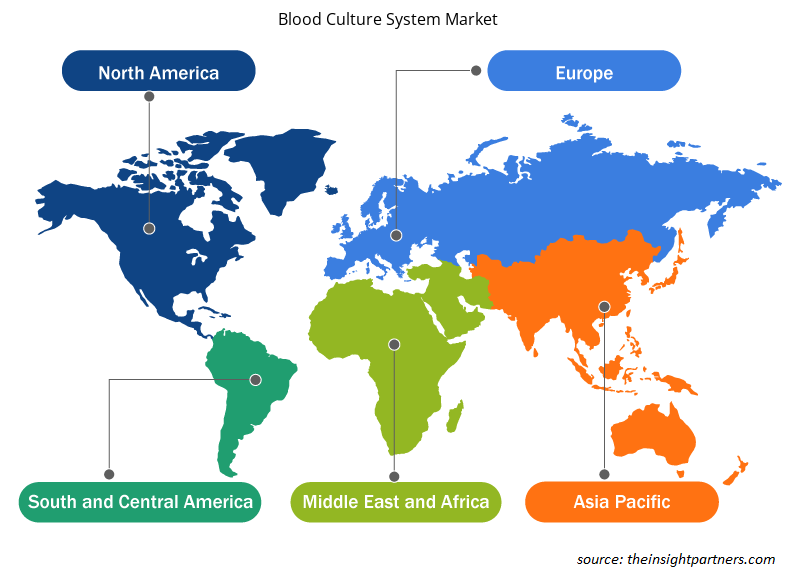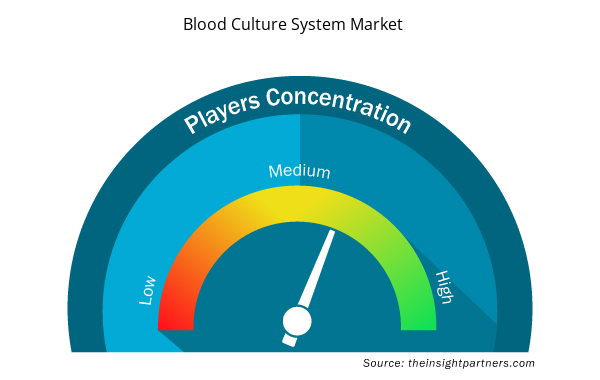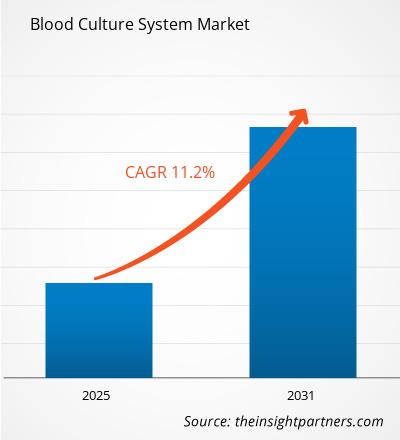Si prevede che il mercato dei sistemi per emocolture registrerà un CAGR dell'11,2% dal 2023 al 2031, con una dimensione di mercato in espansione da XX milioni di dollari nel 2023 a XX milioni di dollari entro il 2031.
Il report è segmentato per Prodotto (Materiali di Consumo, Strumenti), Tecnologia (Tecnologie Basate sulla Coltura, Tecnologie Molecolari, Tecnologie Proteomiche). Il report presenta inoltre analisi basate sull'Applicazione (Batteremia, Fungemia, Micobatteri). L'analisi globale è ulteriormente suddivisa a livello regionale e nei principali Paesi. Il report offre il valore in USD per l'analisi e i segmenti di cui sopra.
Scopo del rapporto
Il report Blood Culture System Market di The Insight Partners mira a descrivere il panorama attuale e la crescita futura, i principali fattori trainanti, le sfide e le opportunità. Ciò fornirà spunti a vari stakeholder aziendali, come:
- Fornitori/produttori di tecnologia: per comprendere le dinamiche di mercato in evoluzione e conoscere le potenziali opportunità di crescita, consentendo loro di prendere decisioni strategiche informate.
- Investitori: condurre un'analisi completa delle tendenze in merito al tasso di crescita del mercato, alle proiezioni finanziarie del mercato e alle opportunità esistenti lungo la catena del valore.
- Enti di regolamentazione: regolamentano le politiche e le attività di controllo sul mercato allo scopo di ridurre al minimo gli abusi, preservare la fiducia degli investitori e sostenere l'integrità e la stabilità del mercato.
Segmentazione del mercato dei sistemi di coltura del sangue
Prodotto
- Materiali di consumo
- Strumenti
Tecnologia
- Tecnologie basate sulla cultura
- Tecnologie molecolari
- Tecnologie proteomiche
Applicazione
- Batteriemia
- Fungemia
- Micobatteri
Geografia
- America del Nord
- Europa
- Asia-Pacifico
- America del Sud e Centro
- Medio Oriente e Africa
Geografia
- America del Nord
- Europa
- Asia-Pacifico
- America del Sud e Centro
- Medio Oriente e Africa
Personalizza questo report in base alle tue esigenze
Riceverai la personalizzazione gratuita di qualsiasi report, comprese parti di questo report, o analisi a livello nazionale, pacchetto dati Excel, oltre a usufruire di grandi offerte e sconti per start-up e università
- Scopri le principali tendenze di mercato in questo rapporto.Questo campione GRATUITO includerà analisi di dati che spaziano dalle tendenze di mercato alle stime e alle previsioni.
Driver di crescita del mercato dei sistemi di coltura del sangue
- Aumento della prevalenza di malattie infettive: le malattie infettive, come le infezioni del flusso sanguigno e la sepsi, aumentano la domanda di sistemi di emocoltura, favorendo così la crescita del mercato. Insieme all'avanzamento di metodi diagnostici rapidi, i professionisti sanitari si muovono verso l'accuratezza nella diagnosi e, di conseguenza, la necessità di sistemi di emocoltura avanzati aumenta con il tempo e alla fine si traduce in un trattamento adeguato e risultati migliori per i pazienti.
- Innovazioni tecniche: questo mercato è ulteriormente stimolato dalle innovazioni nella tecnologia delle emocolture, tra cui sistemi automatizzati e tecniche di rilevamento avanzate. C'è stato un grande miglioramento nella sensibilità e nel tempo necessario per rilevare i patogeni, tutti fattori che hanno ulteriormente accelerato la diagnosi e il trattamento in ambienti di terapia intensiva e ampliato la capacità di laboratorio.
- Consapevolezza della sepsi: una maggiore conoscenza della sepsi e l'elevato tasso di mortalità acuta incoraggiano anche più iniziative sanitarie a concentrarsi sulla diagnosi e sul trattamento precoci. I medici hanno ritenuto che i test tempestivi delle emocolture fossero indispensabili nella gestione della sepsi e, quindi, ben posizionati per creare una domanda crescente nel mercato di sistemi di emocolture affidabili e supporto alla crescita.
Tendenze future del mercato dei sistemi di coltura del sangue
- Tendenza crescente verso l'automazione: la tendenza emergente nel mercato dei sistemi di emocoltura è l'automazione. Il processo dei sistemi di emocoltura automatizzati continua ad affrontare la crescente produttività, a ridurre gli errori umani e ad avere una più rapida elaborazione dei risultati. Questa tendenza è indicativa della maggiore richiesta nel settore sanitario di efficienza e accuratezza nei processi diagnostici.
- Integrazione LIS: i sistemi di emocoltura sono altamente accoppiati con i sistemi informativi di laboratorio. L'accoppiamento dei sistemi rende la gestione dei dati e i flussi di lavoro più efficienti, migliorando il monitoraggio dei campioni, la condivisione dei risultati in tempo reale e il coordinamento tra laboratori e team clinici, quindi una buona assistenza ai pazienti.
- Concentrarsi sulla diagnosi rapida: la domanda di emocoltura aumenta con una crescente enfasi sulle capacità di diagnosi rapida. La domanda attuale si sta spostando verso l'uso di tecnologie che forniscono risultati più rapidamente, tra cui la diagnosi molecolare e il sequenziamento di nuova generazione. Ciò è guidato da una pressante necessità di una decisione terapeutica in terapia intensiva e di emergenza.
Opportunità di mercato per i sistemi di emocoltura
- Espansione nei mercati emergenti: il mercato dei sistemi di emocoltura offre opportunità anche nelle economie emergenti, dove si sta sviluppando l'infrastruttura sanitaria. Anche gli investimenti nella diagnostica di laboratorio nei mercati emergenti sono in aumento e la crescente prevalenza di malattie in questi paesi porta a una maggiore domanda di emocolture sofisticate, che rappresenterebbero il percorso di crescita per i produttori che cercano di rafforzare la loro impronta globale.
- Emersione di tecnologie di nuova generazione: ci sono molte opportunità per sviluppare la prossima generazione di tecnologie di emocoltura con maggiore sensibilità e velocità. Tecnologie come i test multiplex e i sistemi di rilevamento automatizzati promettono di rivoluzionare la diagnosi delle infezioni e soddisferanno l'elevata domanda da parte degli ambienti clinici di soluzioni di test rapide e accurate.
- Collaborazioni e partnership: le collaborazioni e le partnership strategiche tra aziende diagnostiche, operatori sanitari e istituti di ricerca nel mercato delle emocolture si riveleranno preziose opportunità che potrebbero dare vita ad alleanze strategiche per innovare, migliorare l'offerta di prodotti e aumentare la penetrazione del mercato, il che porterà infine al miglioramento del rilevamento e della gestione delle infezioni.
Approfondimenti regionali sul mercato dei sistemi di coltura del sangue
Le tendenze regionali e i fattori che influenzano il mercato del sistema di coltura ematica durante il periodo di previsione sono stati ampiamente spiegati dagli analisti di Insight Partners. Questa sezione discute anche i segmenti e la geografia del mercato del sistema di coltura ematica in Nord America, Europa, Asia Pacifico, Medio Oriente e Africa e Sud e Centro America.

- Ottieni i dati specifici regionali per il mercato dei sistemi di coltura del sangue
Ambito del rapporto di mercato del sistema di coltura del sangue
| Attributo del report | Dettagli |
|---|---|
| Dimensioni del mercato nel 2023 | XX milioni di dollari USA |
| Dimensioni del mercato entro il 2031 | XX milioni di dollari USA |
| CAGR globale (2023-2031) | 11,2% |
| Dati storici | 2021-2022 |
| Periodo di previsione | 2024-2031 |
| Segmenti coperti | Per Prodotto
|
| Regioni e Paesi coperti | America del Nord
|
| Leader di mercato e profili aziendali chiave |
|
Densità degli attori del mercato del sistema di coltura del sangue: comprendere il suo impatto sulle dinamiche aziendali
Il mercato del Blood Culture System Market sta crescendo rapidamente, spinto dalla crescente domanda degli utenti finali dovuta a fattori quali l'evoluzione delle preferenze dei consumatori, i progressi tecnologici e una maggiore consapevolezza dei benefici del prodotto. Con l'aumento della domanda, le aziende stanno ampliando le loro offerte, innovando per soddisfare le esigenze dei consumatori e capitalizzando sulle tendenze emergenti, il che alimenta ulteriormente la crescita del mercato.
La densità degli operatori di mercato si riferisce alla distribuzione di aziende o società che operano in un particolare mercato o settore. Indica quanti concorrenti (operatori di mercato) sono presenti in un dato spazio di mercato in relazione alle sue dimensioni o al valore di mercato totale.
Le principali aziende che operano nel mercato dei sistemi di emocoltura sono:
- Helmer scientifico
- Becton, Dickinson e compagnia
- Biomerieux SA
- Thermo Fisher Scientific, Inc.
- Cefeide
Disclaimer : le aziende elencate sopra non sono classificate secondo un ordine particolare.

- Ottieni una panoramica dei principali attori del mercato dei sistemi di coltura del sangue
Punti di forza chiave
- Copertura completa: il rapporto copre in modo completo l'analisi di prodotti, servizi, tipologie e utenti finali del mercato dei sistemi di emocoltura, fornendo una panoramica olistica.
- Analisi degli esperti: il rapporto è compilato sulla base della conoscenza approfondita di esperti e analisti del settore.
- Informazioni aggiornate: il rapporto garantisce la pertinenza aziendale grazie alla copertura di informazioni recenti e tendenze nei dati.
- Opzioni di personalizzazione: questo report può essere personalizzato per soddisfare le esigenze specifiche del cliente e adattarsi in modo appropriato alle strategie aziendali.
Il rapporto di ricerca sul mercato dei sistemi di coltura ematica può quindi aiutare a guidare il percorso di decodificazione e comprensione dello scenario del settore e delle prospettive di crescita. Sebbene possano esserci alcune preoccupazioni valide, i vantaggi complessivi di questo rapporto tendono a superare gli svantaggi.
- Analisi storica (2 anni), anno base, previsione (7 anni) con CAGR
- Analisi PEST e SWOT
- Valore/volume delle dimensioni del mercato - Globale, regionale, nazionale
- Industria e panorama competitivo
- Set di dati Excel


- Toothpaste Market
- Vessel Monitoring System Market
- Advanced Planning and Scheduling Software Market
- Predictive Maintenance Market
- 3D Audio Market
- Employment Screening Services Market
- Semiconductor Metrology and Inspection Market
- Artificial Intelligence in Healthcare Diagnosis Market
- Virtual Pipeline Systems Market
- Maritime Analytics Market

Report Coverage
Revenue forecast, Company Analysis, Industry landscape, Growth factors, and Trends

Segment Covered
This text is related
to segments covered.

Regional Scope
North America, Europe, Asia Pacific, Middle East & Africa, South & Central America

Country Scope
This text is related
to country scope.
Domande frequenti
The blood culture system market is estimated to grow with a CAGR of 11.2% from 2023 to 2031
Asia-Pacific region is likely to witness the fastest growth rate during the forecast period.
The blood culture system market majorly consists of players such as BD, Biomérieux SA, Thermo Fisher Scientific, Inc. among others
The market drivers include the rising prevalence of bloodstream infections, and Innovations in blood culture technology are driving the blood culture system market
Integration with laboratory information systems (LIS) is likely to remain the key trend during the forecast period
North America dominated the blood culture system market in 2023
Trends and growth analysis reports related to Life Sciences : READ MORE..
1. Helmer Scientific
2. Becton, Dickinson and Company
3. Biomérieux SA
4. Thermo Fisher Scientific, Inc.
5. Cepheid
6. Nanosphere, Inc.
7. Bruker Corporation
8. Beckman Coulter
9. Roche Diagnostics
10. Iridica
11. Biosystems
The Insight Partners performs research in 4 major stages: Data Collection & Secondary Research, Primary Research, Data Analysis and Data Triangulation & Final Review.
- Data Collection and Secondary Research:
As a market research and consulting firm operating from a decade, we have published and advised several client across the globe. First step for any study will start with an assessment of currently available data and insights from existing reports. Further, historical and current market information is collected from Investor Presentations, Annual Reports, SEC Filings, etc., and other information related to company’s performance and market positioning are gathered from Paid Databases (Factiva, Hoovers, and Reuters) and various other publications available in public domain.
Several associations trade associates, technical forums, institutes, societies and organization are accessed to gain technical as well as market related insights through their publications such as research papers, blogs and press releases related to the studies are referred to get cues about the market. Further, white papers, journals, magazines, and other news articles published in last 3 years are scrutinized and analyzed to understand the current market trends.
- Primary Research:
The primarily interview analysis comprise of data obtained from industry participants interview and answers to survey questions gathered by in-house primary team.
For primary research, interviews are conducted with industry experts/CEOs/Marketing Managers/VPs/Subject Matter Experts from both demand and supply side to get a 360-degree view of the market. The primary team conducts several interviews based on the complexity of the markets to understand the various market trends and dynamics which makes research more credible and precise.
A typical research interview fulfils the following functions:
- Provides first-hand information on the market size, market trends, growth trends, competitive landscape, and outlook
- Validates and strengthens in-house secondary research findings
- Develops the analysis team’s expertise and market understanding
Primary research involves email interactions and telephone interviews for each market, category, segment, and sub-segment across geographies. The participants who typically take part in such a process include, but are not limited to:
- Industry participants: VPs, business development managers, market intelligence managers and national sales managers
- Outside experts: Valuation experts, research analysts and key opinion leaders specializing in the electronics and semiconductor industry.
Below is the breakup of our primary respondents by company, designation, and region:

Once we receive the confirmation from primary research sources or primary respondents, we finalize the base year market estimation and forecast the data as per the macroeconomic and microeconomic factors assessed during data collection.
- Data Analysis:
Once data is validated through both secondary as well as primary respondents, we finalize the market estimations by hypothesis formulation and factor analysis at regional and country level.
- Macro-Economic Factor Analysis:
We analyse macroeconomic indicators such the gross domestic product (GDP), increase in the demand for goods and services across industries, technological advancement, regional economic growth, governmental policies, the influence of COVID-19, PEST analysis, and other aspects. This analysis aids in setting benchmarks for various nations/regions and approximating market splits. Additionally, the general trend of the aforementioned components aid in determining the market's development possibilities.
- Country Level Data:
Various factors that are especially aligned to the country are taken into account to determine the market size for a certain area and country, including the presence of vendors, such as headquarters and offices, the country's GDP, demand patterns, and industry growth. To comprehend the market dynamics for the nation, a number of growth variables, inhibitors, application areas, and current market trends are researched. The aforementioned elements aid in determining the country's overall market's growth potential.
- Company Profile:
The “Table of Contents” is formulated by listing and analyzing more than 25 - 30 companies operating in the market ecosystem across geographies. However, we profile only 10 companies as a standard practice in our syndicate reports. These 10 companies comprise leading, emerging, and regional players. Nonetheless, our analysis is not restricted to the 10 listed companies, we also analyze other companies present in the market to develop a holistic view and understand the prevailing trends. The “Company Profiles” section in the report covers key facts, business description, products & services, financial information, SWOT analysis, and key developments. The financial information presented is extracted from the annual reports and official documents of the publicly listed companies. Upon collecting the information for the sections of respective companies, we verify them via various primary sources and then compile the data in respective company profiles. The company level information helps us in deriving the base number as well as in forecasting the market size.
- Developing Base Number:
Aggregation of sales statistics (2020-2022) and macro-economic factor, and other secondary and primary research insights are utilized to arrive at base number and related market shares for 2022. The data gaps are identified in this step and relevant market data is analyzed, collected from paid primary interviews or databases. On finalizing the base year market size, forecasts are developed on the basis of macro-economic, industry and market growth factors and company level analysis.
- Data Triangulation and Final Review:
The market findings and base year market size calculations are validated from supply as well as demand side. Demand side validations are based on macro-economic factor analysis and benchmarks for respective regions and countries. In case of supply side validations, revenues of major companies are estimated (in case not available) based on industry benchmark, approximate number of employees, product portfolio, and primary interviews revenues are gathered. Further revenue from target product/service segment is assessed to avoid overshooting of market statistics. In case of heavy deviations between supply and demand side values, all thes steps are repeated to achieve synchronization.
We follow an iterative model, wherein we share our research findings with Subject Matter Experts (SME’s) and Key Opinion Leaders (KOLs) until consensus view of the market is not formulated – this model negates any drastic deviation in the opinions of experts. Only validated and universally acceptable research findings are quoted in our reports.
We have important check points that we use to validate our research findings – which we call – data triangulation, where we validate the information, we generate from secondary sources with primary interviews and then we re-validate with our internal data bases and Subject matter experts. This comprehensive model enables us to deliver high quality, reliable data in shortest possible time.


 Ottieni un campione gratuito per questo repot
Ottieni un campione gratuito per questo repot